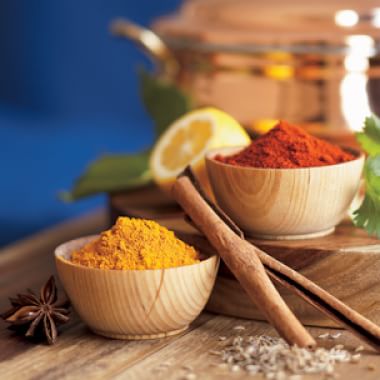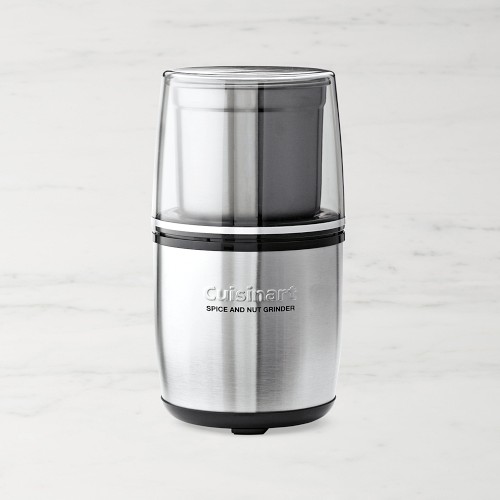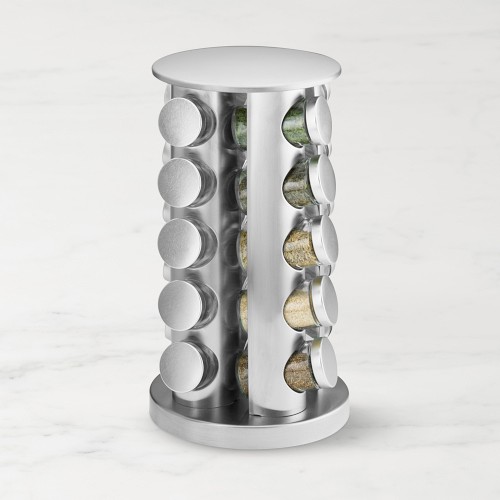
The average person's love for spices comes second only to his or her love for salt and sugar. These highly scented seeds, barks, roots and fruits have been commodities since prehistory. They have been used since ancient times in sacred rituals, to anoint royalty, to mask the taste of spoiling foods, and to add aroma and flavor to prepared dishes.
For centuries, spices had to be brought overland by camel from Asia and India, and the spice trade was monopolized by the Arabs. By medieval times, spices were almost as valuable as gold, and Venice controlled their commerce, becoming a great power in the process. Christopher Columbus was only one of many European explorers who hoped to break the Venetian hold on the spice trade by finding a sea route westward to the spice lands. North America just happened to be in the way.
Spices are still valuable today, for only a small amount is needed to add a haunting or heady fragrance and taste to food. The cuisines of India and Indonesia, the two countries where most spices are still grown, use a wide range of them. Spain, Mexico, Ethiopia and North Africa also depend on blends of spices to perfume their foods, reflecting their ancient connections with Arabic cuisine. Northern European countries continue to demonstrate their love of spices in a wide range of foods both sweet and savory, including gingerbread, sauerbraten, honey cake, mulled wine and cardamom-scented butter cookies.
Selecting
Ideally, spices should be bought whole and ground just before use. But in the interest of convenience, cooks stock many spices in two forms, whole and ground. Buy your spices, especially ground ones, in the smallest amounts you can, as they lose flavor over time. It is better to go to a natural-food store or a specialty-food shop that sells spices in bulk and buy only a little of each than to buy jars or cans of spices that will grow stale and have to be thrown out. Be sure your merchant stores spices in a cool, dark place.
Storing
Keep spices in tightly closed containers in a cool, dark place, such as a pantry, rather than beside the stove or elsewhere in a bright kitchen. Some cooks keep their spices in alphabetical order for ease of selection. If you buy your spices in bulk, purchase some empty glass spice jars for storing them. Whole spices kept this way will last for about 1 year; ground spices should be replaced after 6 months.
Preparing
For grinding small quantities of spices, use a mortar and pestle or a pepper mill reserved for spices. Or buy a small electric coffee grinder and use it only for grinding spices. Grind just the amount you need. To add whole spices to stews and mulled wine, tie them in a cheesecloth square or place them in a tea ball for easy removal. If using an orange or onion and whole cloves, stud the orange or onion with the cloves. Whole peppercorns should be bruised or cracked before using.
Toasting
To intensify their flavor, toast spices in a dry fry pan. It is best to toast whole spices before grinding, but ground spices may be toasted if you keep a close eye on them. Some recipes call for frying spices in oil. Take great care not to burn them.
Put the spices in a small, heavy fry pan (cast iron is ideal) over medium heat.Toast, stirring constantly, until fragrant. Immediately empty the spices into a bowl and stir them to stop the cooking.
Adapted from Williams-Sonoma Kitchen Companion (Time-Life Books, 2000).
For centuries, spices had to be brought overland by camel from Asia and India, and the spice trade was monopolized by the Arabs. By medieval times, spices were almost as valuable as gold, and Venice controlled their commerce, becoming a great power in the process. Christopher Columbus was only one of many European explorers who hoped to break the Venetian hold on the spice trade by finding a sea route westward to the spice lands. North America just happened to be in the way.
Spices are still valuable today, for only a small amount is needed to add a haunting or heady fragrance and taste to food. The cuisines of India and Indonesia, the two countries where most spices are still grown, use a wide range of them. Spain, Mexico, Ethiopia and North Africa also depend on blends of spices to perfume their foods, reflecting their ancient connections with Arabic cuisine. Northern European countries continue to demonstrate their love of spices in a wide range of foods both sweet and savory, including gingerbread, sauerbraten, honey cake, mulled wine and cardamom-scented butter cookies.
Selecting
Ideally, spices should be bought whole and ground just before use. But in the interest of convenience, cooks stock many spices in two forms, whole and ground. Buy your spices, especially ground ones, in the smallest amounts you can, as they lose flavor over time. It is better to go to a natural-food store or a specialty-food shop that sells spices in bulk and buy only a little of each than to buy jars or cans of spices that will grow stale and have to be thrown out. Be sure your merchant stores spices in a cool, dark place.
Storing
Keep spices in tightly closed containers in a cool, dark place, such as a pantry, rather than beside the stove or elsewhere in a bright kitchen. Some cooks keep their spices in alphabetical order for ease of selection. If you buy your spices in bulk, purchase some empty glass spice jars for storing them. Whole spices kept this way will last for about 1 year; ground spices should be replaced after 6 months.
Preparing
For grinding small quantities of spices, use a mortar and pestle or a pepper mill reserved for spices. Or buy a small electric coffee grinder and use it only for grinding spices. Grind just the amount you need. To add whole spices to stews and mulled wine, tie them in a cheesecloth square or place them in a tea ball for easy removal. If using an orange or onion and whole cloves, stud the orange or onion with the cloves. Whole peppercorns should be bruised or cracked before using.
Toasting
To intensify their flavor, toast spices in a dry fry pan. It is best to toast whole spices before grinding, but ground spices may be toasted if you keep a close eye on them. Some recipes call for frying spices in oil. Take great care not to burn them.
Put the spices in a small, heavy fry pan (cast iron is ideal) over medium heat.Toast, stirring constantly, until fragrant. Immediately empty the spices into a bowl and stir them to stop the cooking.
Adapted from Williams-Sonoma Kitchen Companion (Time-Life Books, 2000).
Related Recipes:
- Spiced Beef Brisket →
- Grilled Leg of Lamb with Mint Raita →
- Seeded Crackers →
- Double-Ginger Snaps →
- Spiced Apple Coffee Cake →
- Moroccan Lamb Stew →
- Baby Bok Choy and Beef Noodle Soup with Warm Spices →
- Spiced Rosemary Nuts →
- Homemade Pickling Spice →
- Persian-Spiced Pork Chops →
- Indian-Spiced Mixed Nuts →
- Baked Spiced Apples →
Related Tips:
Recommended Products
-
$39.95
(240)

- $74.95
- $69.95










